
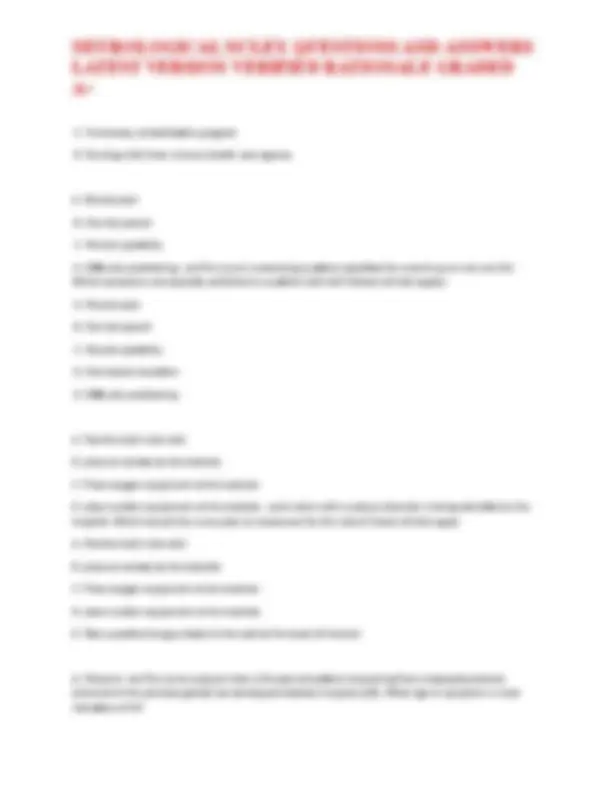
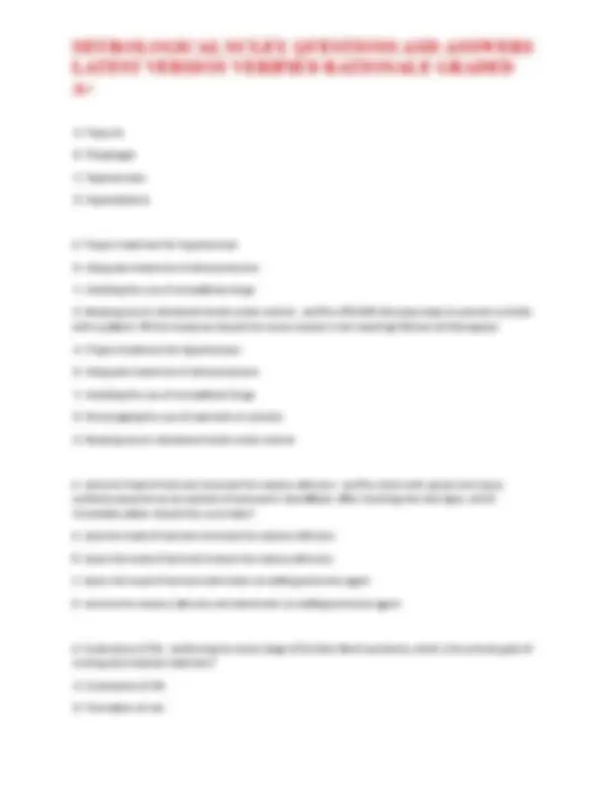
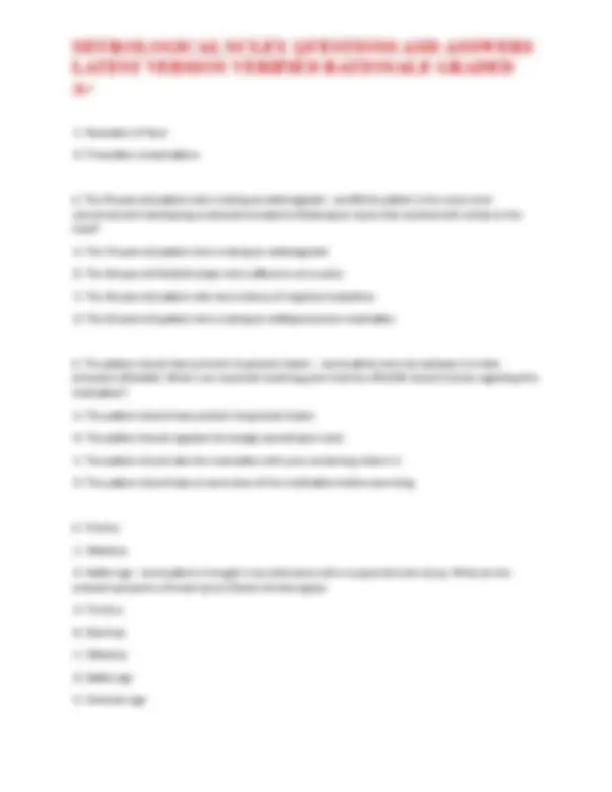
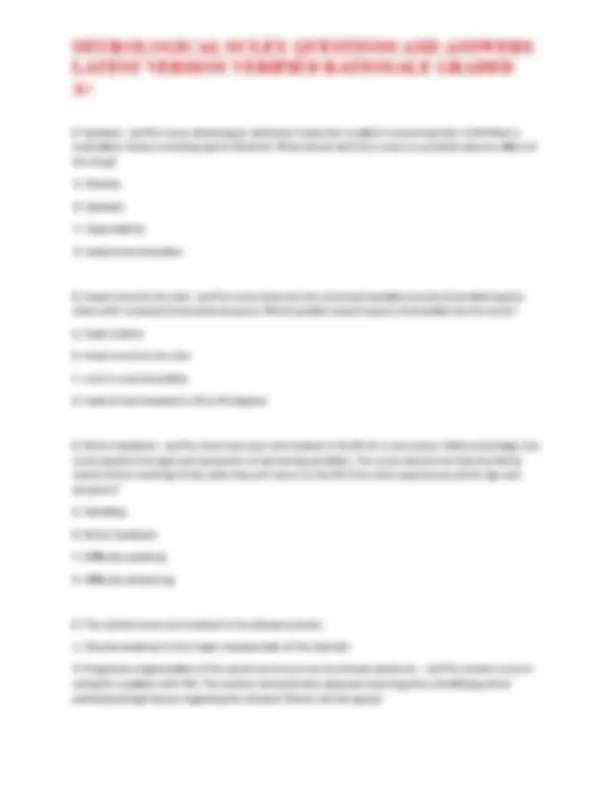
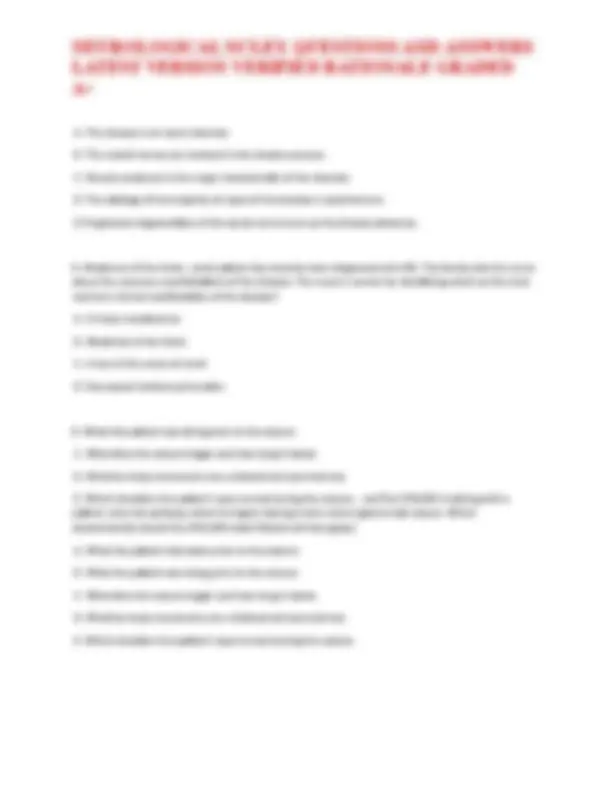
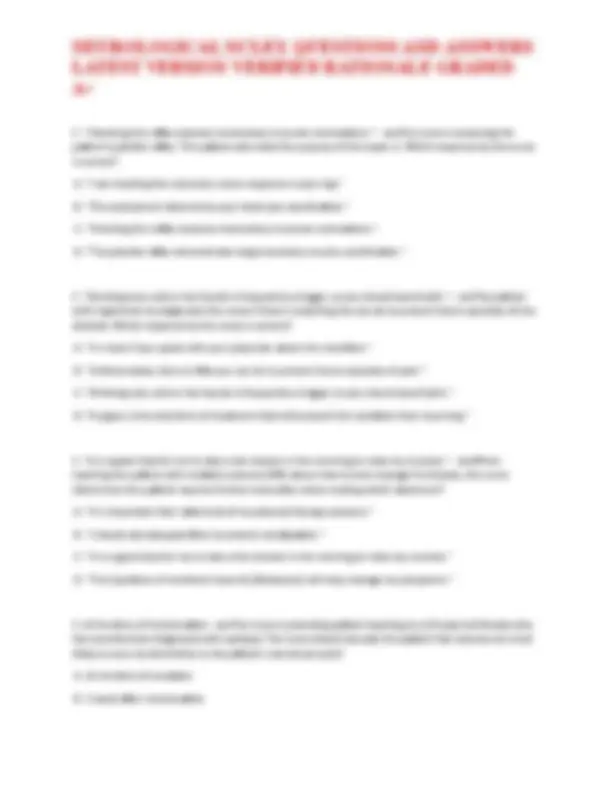
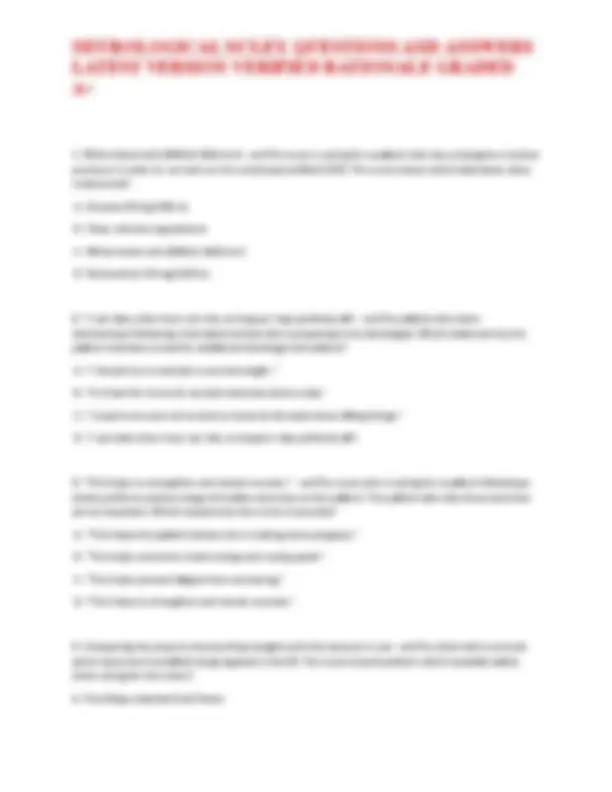
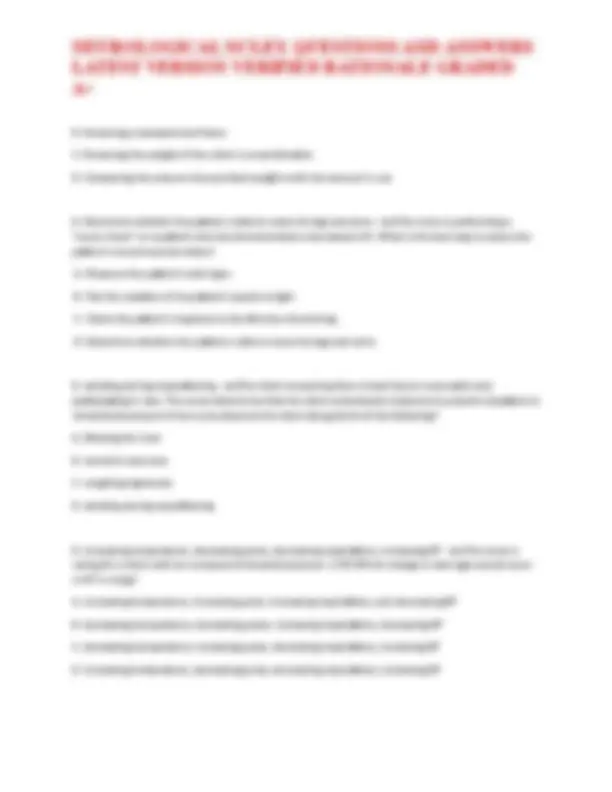
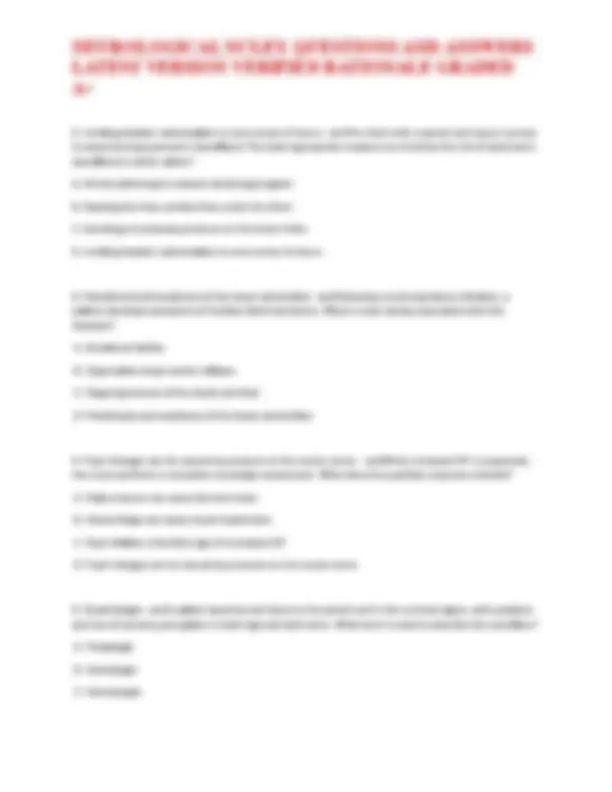


Study with the several resources on Docsity

Earn points by helping other students or get them with a premium plan


Prepare for your exams
Study with the several resources on Docsity

Earn points to download
Earn points by helping other students or get them with a premium plan
Community
Ask the community for help and clear up your study doubts
Discover the best universities in your country according to Docsity users
Free resources
Download our free guides on studying techniques, anxiety management strategies, and thesis advice from Docsity tutors
A collection of nclex-style questions and answers focused on neurological conditions. It covers a wide range of topics, including brain injuries, stroke, cerebrospinal fluid, and neurological disorders like als and guillain-barré syndrome. Each question is accompanied by a detailed rationale, making it an excellent resource for nursing students preparing for the nclex exam.
Typology: Exams
1 / 17

This page cannot be seen from the preview
Don't miss anything!










A. " I should drink extra fluids for the remainder of the day." - ansThe client has just undergone computed tomography ( CT) scanning with a contrast medium. Which statement by the client demonstrates an understanding of the post procedure care? A. " I should drink extra fluids for the remainder of the day." B. " I should not take any medications for atleast 4 hours." C. "I should eat lightly for the remainder of the day." D. " I should rest quietly for the remainder of the day." A. Brain atrophy - ansWhich of the following conditions can increase the risk for torn vessels and contusion on the brain if an accident that involves brain injury occurs? A. Brain atrophy B. Hydrocephalus C. Heterotopic ossification D. Increased intracranial pressure (ICP) A. Cerebral thrombosis C. Cerebral hemorrhage E. Atherosclerosis of the arteries in the head and neck - ansThe nurse is providing teaching to a group of patients regarding CVA (stroke). The patients demonstrate an understanding of the teaching when listing which factors as being the possible cause of a stroke? (Select all that apply.) A. Cerebral thrombosis B. Cerebral encephalitis C. Cerebral hemorrhage D. Meningococcal meningitis E. Atherosclerosis of the arteries in the head and neck A. CSF circulates within the subarachnoid space. B. CSF cushions and protects the brain and spinal cord.
D. CSF is reabsorbed by the arachnoid villi at the same rate at which it is formed. E. CSF is formed continuously within the ventricles of the brain as a filtrate from the blood. - ansThe nurse is measuring the pressure of the CSF. Which statement accurately describes CSF? (Select all that apply.) A. CSF circulates within the subarachnoid space. B. CSF cushions and protects the brain and spinal cord. C. CSF normal pressure is 90 to 150 cm water pressure (cm H2O). D. CSF is reabsorbed by the arachnoid villi at the same rate at which it is formed. E. CSF is formed continuously within the ventricles of the brain as a filtrate from the blood. A. Decreasing level of consciousness (LOC) - ansThe nurse is assessing a patient who has a brain tumor. What assessment finding is most indicative of increased ICP in this patient? A. Decreasing level of consciousness (LOC) B. Elevated temperature C. Agitation and hostility D. Increasing blood pressure (BP) A. Halo Test - ansAfter a head injury, the patient begins to have drainage from the nose. The nurse assesses the drainage by which method? A. Halo test B. Tinel sign C. Battle sign D. Babinski sign A. Hospice Services - ansDuring the advanced stages of amyotrophic lateral sclerosis (ALS), which service would be most beneficial to the family and patient? A. Hospice services B. In-home physical therapy
A. Polyuria B. Polyphagia C. Hypertension D. Hyperkalemia A. Proper treatment for hypertension B. Adequate treatment of atherosclerosis C. Avoiding the use of recreational drugs E. Keeping serum cholesterol levels under control - ansThe LPN/LVN discusses ways to prevent a stroke with a patient. Which measures should the nurse include in her teaching? (Select all that apply.) A. Proper treatment for hypertension B. Adequate treatment of atherosclerosis C. Avoiding the use of recreational drugs D. Encouraging the use of seat belts in vehicles E. Keeping serum cholesterol levels under control A. raise the head of bed and removed the noxious stimulus - ansThe client with spinal cord injury suddenly experiences an episode of autonomic dysreflexia. After checking the vital signs, which immediate action should the nurse take? A. raise the head of bed and removed the noxious stimulus B. lower the head of bed and remove the noxious stimulus C. lower the head of bed and administer an antihypertensive agent D. remove the noxious stimulus and administer an antihypertensive agent A. Sustenance of life - ansDuring the acute stage of Guillain-Barré syndrome, what is the priority goal of nursing and medical treatment? A. Sustenance of life B. Promotion of rest
C. Reduction of fever D. Prevention complications A. The 76-year-old patient who is taking an anticoagulant - ansWhich patient is the nurse most concerned with developing a subdural hematoma following an injury that resulted with a blow to the head? A. The 76-year-old patient who is taking an anticoagulant B. The 16-year-old football player who suffered a concussion C. The 36-year-old patient who has a history of migraine headaches D. The 56-year-old patient who is taking an antihypertensive medication A. The patient should have periodic drug levels drawn. - ansA patient who has epilepsy is to take phenytoin (Dilantin). What is an important teaching point that the LPN/LVN should include regarding this medication? A. The patient should have periodic drug levels drawn. B. The patient should regulate the dosage according to need. C. The patient should take the medication with juice containing vitamin C. D. The patient should take an extra dose of the medication before exercising. A. Tinnitus C. Ottorhea D. Battle sign - ansA patient is bought in by ambulance with a suspected brain injury. What are the outward symptoms of head injury? (Select all that apply.) A. Tinnitus B. Diarrhea C. Ottorhea D. Battle sign E. Chvostek sign
C. "I need to check her pupils frequently with a flashlight to be sure her pupils constrict." D. "I need to watch for any changes in the level of consciousness or vomiting for 48 hours." B. "The procedure is safe and painless; you will hear a clicking noise as the CT machine rotates." - ansA patient who is to have computed tomography (CT scan) of the brain voices concern about the procedure. The LPN/LVN can best allay the patient's fears by making which statement? A. "CT scans use only a small amount of radioactive material injected into your brain." B. "The procedure is safe and painless; you will hear a clicking noise as the CT machine rotates." C. "You will probably be given something to make you drowsy and deaden the pain during the CT scan." C. "CT scanning is a new procedure, and since it involves the brain, I think the doctor can answer your questions better than I can." B. Aphasia - ansA patient has had a left-sided cerebrovascular accident (CVA). Which condition does the nurse expect the patient to have as a result of the CVA? A. Ataxia B. Aphasia C. Dyslexia D. Quadriplegia B. CN II and CN III - ansThe nurse is caring for a patient who suffered massive head trauma, and suspected increased intracranial pressure (ICP) from an automobile accident. Which cranial nerves are most appropriate to check at this time? A. CN I and CN II B. CN II and CN III C. CN III and CN IV D .CN IV and CN V
B. Epistaxis - ansThe nurse obtaining an admission history for a patient recovering from a CVA finds a medication history including aspirin (Ecotrin). What should alert the nurse to a possible adverse effect of this drug? A. Nausea B. Epistaxis C. Hyperactivity D. Abdominal distention B. Head turned to the side - ansThe nurse observes the unlicensed assistive personnel positioning the client with increased intracranial pressure. Which position would require intervention by the nurse? A. Head midline B. Head turned to the side C. neck in neutral position D. head of bed elevated to 30 to 45 degrees B. Minor headache - ansThe client was seen and treated in the ER for a concussion. Before discharge, the nurse explains the signs and symptoms of worsening condition. The nurse determines that the family needs further teaching if they state they will return to the ED if the client experiences which sign and symptom? A. Vomiting B. Minor headache C. Difficulty speaking D. Difficulty awakening B. The cranial nerves are involved in the disease process. C. Muscle weakness is the major characteristic of the disorder. E.Progressive degeneration of the spinal cord occurs as the disease advances. - ansThe student nurse is caring for a patient with MG. The student demonstrates adequate learning when identifying which pathophysiologic factors regarding the disease? (Select all that apply.)
C. "Checking this reflex assesses involuntary muscular contractions." - ansThe nurse is assessing the patient's patellar reflex. The patient asks what the purpose of this exam is. Which response by the nurse is correct? A. "I am checking the conscious nerve response in your leg." B. "This assessment determines your hand-eye coordination." C. "Checking this reflex assesses involuntary muscular contractions." D. "The patellar reflex demonstrates large voluntary muscle coordination." C. "Drinking very cold or hot liquids is frequently a trigger, so you should avoid both." - ansThe patient with trigeminal neuralgia asks the nurse if there is anything she can do to prevent future episodes of the disorder. Which response by the nurse is correct? A. "It is best if you speak with your physician about this condition." B. "Unfortunately, there is little you can do to prevent future episodes of pain." C. "Drinking very cold or hot liquids is frequently a trigger, so you should avoid both." D. "Surgery is the only form of treatment that will prevent this condition from recurring." C. "It is a good idea for me to take a hot shower in the morning to relax my muscles." - ansWhen teaching the patient with multiple sclerosis (MS) about how to best manage his disease, the nurse determines the patient requires further instruction when making which statement? A. "It is important that I attend all of my physical therapy sessions." B. "I should eat adequate fiber to prevent constipation." C. "It is a good idea for me to take a hot shower in the morning to relax my muscles." D. "The injections of interferon beta-1b (Betaseron) will help manage my symptoms." C. At the time of menstruation - ansThe nurse is providing patient teaching to a 23-year-old female who has recently been diagnosed with epilepsy. The nurse should educate the patient that seizures are most likely to occur at which time in the patient's menstrual cycle? A. At the time of ovulation B. 1 week after menstruation
C. At the time of menstruation D. 1 week before menstruation C. Because the myasthenic patient can suffer from exaggerated and bizarre effects from a variety of drugs. - ansWhy should the nurse check with the physician to be sure that she knows a patient has MG when prescribing medications? A. Because the patient needs sublingual medications due to excessive salivation. B. Because when the patient is in remission, certain drugs should not be prescribed. C. Because the myasthenic patient can suffer from exaggerated and bizarre effects from a variety of drugs. D. Because the patient's MG medication, selegiline (Eldepryl), needs to be carefully monitored for patient reactions. C. Head of bed elevated 30 to 45 degrees head and neck midline - ansThe nurse is caring for a client who has undergone craniotomy with a supratentoral incision. The nurse should plan to place the client in which position post-op? A. Head of bed flat, head and neck midline B. Head of bed flat, head turned to the nonoperative side C. Head of bed elevated 30 to 45 degrees head and neck midline D. Head of bed elevated 30 to 45 degrees, head turned to the operative side C. Inability to maintain own airway - ansInterventions to prevent which problem are the priority for a patient with myasthenia gravis (MG)? A. Accidental injury B. Uncontrolled pain C. Inability to maintain own airway D. Decreased functional ability and mobility C. MG - ansFor which condition would a patient most need to have medical alert identification?
C. White blood cells (WBCs) 100/mm3 - ansThe nurse is caring for a patient who has undergone a lumbar puncture in order to run tests on the cerebrospinal fluid (CSF). The nurse knows which laboratory value is abnormal? A. Glucose 60 mg/100 mL B. Clear, colorless appearance C. White blood cells (WBCs) 100/mm D. Total protein 40 mg/100 mL D. "I can take a four hour car ride, as long as I stay perfectly still. - ansThe patient who had a laminectomy following a herniated lumbar disk is preparing to be discharged. Which statement by the patient indicates a need for additional discharge instructions? A. "I should try to maintain a normal weight." B. "It is best for me to do my back exercises twice a day." C. "I need to be sure not to twist or bend at the waist when lifting things." D. "I can take a four hour car ride, as long as I stay perfectly still. D. "This helps to strengthen and retrain muscles " - ansThe nurse who is caring for a patient following a stroke performs passive range-of-motion exercises on the patient. The patient asks why these exercises are so important. Which response by the nurse is accurate? A. "This helps the patient believe she is making some progress." B. "This helps overcome mood swings and crying spells." C. "This helps prevent fatigue from worsening." D. "This helps to strengthen and retrain muscles." D. Comparing the amount of prescribed weights with the amount in use - ansThe client with a cervical spine injury has Crutchfield tongs applied in the ER. The nurse should preform which essential action when caring for this client? A. Providing a standard bed frame
B. Removing a standard bed frame C. Removing the weights if the client is uncomfortable D. Comparing the amount of prescribed weights with the amount in use D. Determine whether the patient is able to move his legs and arms - ansThe nurse is performing a "neuro check" on a patient who has demonstrated a decreased LOC. What is the best way to assess the patient's neuromuscular status? A. Measure the patient's vital signs. B. Test the reaction of the patient's pupils to light. C. Check the patient's response to the stimulus of pinching. D. Determine whether the patient is able to move his legs and arms D. exhaling during respostioning - ansThe client recovering from a head injury is arousable and participating in care. The nurse determines that the client understands measures to prevent elevations in intracranial pressure if the nurse observes the client doing which of the following? A. Blowing the nose B. isometric exercises C. coughing vigorously D. exhaling during repositioning D. increasing temperature, decreasing pulse, decreasing respirations, increasing BP - ansThe nurse is caring for a client with an increased intracranial pressure. ( ICP) Which change in vital signs would occur is ICP is rising? A. increasing temperature, increasing pulse, increasing respirations, and decreasing BP B. decreasing temperature, decreasing pulse, increasing respirations, decreasing BP C. decreasing temperature, increasing pulse, decreasing respirations, increasing BP D. increasing temperature, decreasing pulse, decreasing respirations, increasing BP
D. Quadriplegia D. separates into concentric rings and tests positive for glucose - ansThe client has clear fluid leaking from the nose after a basilar skull fracture. The nurse determines that is is cerebrospinal fluid ( CSF) if the fluid meets which criteria? A. Is grossly bloody in appearance and has a pH of 6 B. Clumps together on the dressing and has a pH of 7 C. Is clear in appearance and tests negative for glucose D. separates into concentric rings and tests positive for glucose D. Severe headache that wakes patient and visual problems - ansA patient has been diagnosed with a cerebral neoplasm. What are the symptoms of a cerebral neoplasm? A. Long-term memory loss and paralysis B. Loss of muscle strength and paresthesia C. Grand mal seizure activity and facial paralysis D. Severe headache that wakes patient and visual problems D. Side- laying with legs pulled up and chin to the chest - ansThe client is having a lumbar puncture preformed. The nurse should place the client in which position for the procedure? A. Supine, in semi-fowlers B. Prone, in slight Trendelenburg C. Prone, with a pillow under the abdomen D. Side- laying with legs pulled up and chin to the chest D. The health care provider reviews the x-rays - ansThe client is admitted to the hospital for observation with a probable minor head injury after an automobile crash. The nurse expects the cervical collar will remain in place until which time? A. The client is taken for spinal x-rays
B. The family comes to visit after surgery C. The nurse needs to provide physical care D. The health care provider reviews the x-rays D. Touch his nose with his left index finger. - ansWhen rating a patient using the Glasgow Coma Scale, what would be appropriate for the LPN/LVN to ask the patient to do in order to test the patient's motor response? A. Roll his eyes in a circle. B. Take a deep breath and exhale. C. Describe the view from his window. D. Touch his nose with his left index finger.